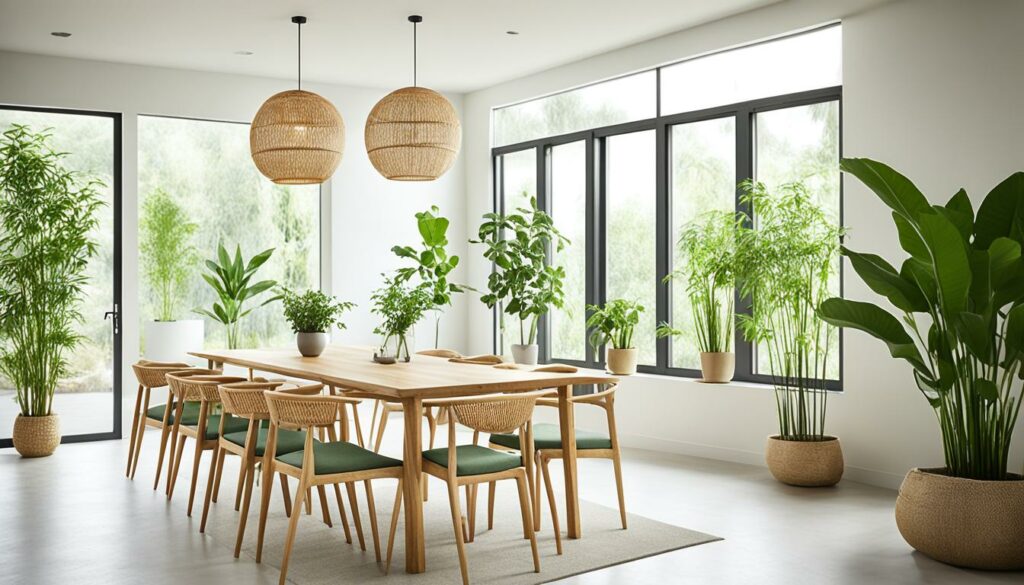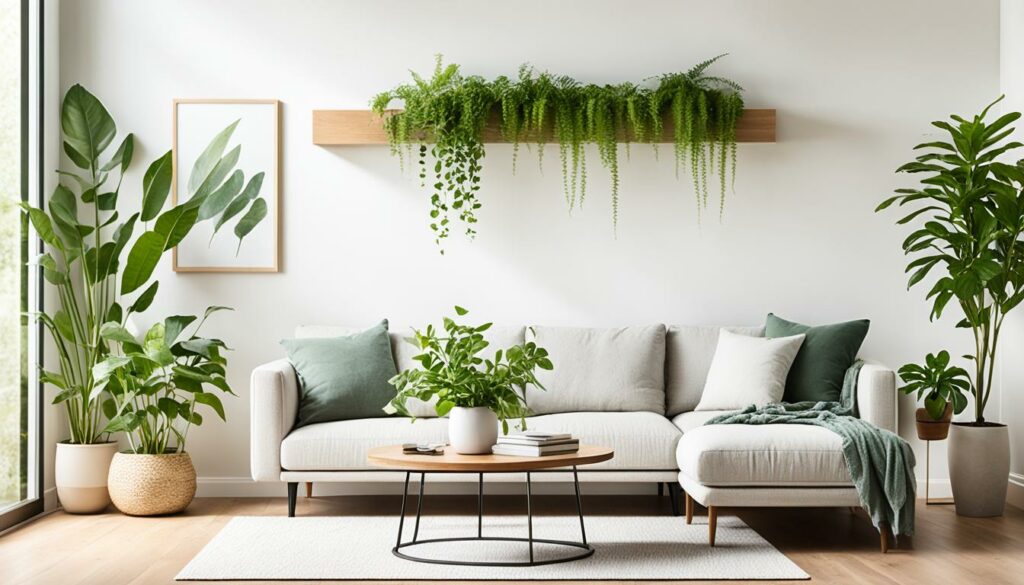On a cool spring morning, someone stands at the edge of a big change. They look at a room that was once full, now peaceful in its simple state. Months of removing things and changing what’s necessary have done more than clear space. This change has brought about a clear sense of purpose, thanks to the idea of living simply and green.
This simpler way of living, focused on being kind to the earth, brings a person back in tune with their surroundings. Choosing to live with less isn’t just a popular choice—it’s a meaningful one. It’s about living quietly yet strongly in a way that says, “less is more.” This choice makes us think about our impact on the world.
The decisions we make to live simply extend out as acts of kindness to our planet. By choosing eco-friendly minimalism, people create lives full of lasting beauty. Each thing they keep and every act they do shows a commitment to caring for our world.
Key Takeaways
- Eco-friendly minimalism is not just a space-saving concept, but a path to environmental consciousness.
- Adopting a minimalist lifestyle can lead to significant reductions in environmental impact.
- Sustainable living requires a shift in thinking from ‘more’ to ‘meaningful.’
- Green living embraces simplicity and responsibility in every aspect of life.
- Each minimalist choice carries the potential for positive global change.
The Philosophy of Eco-Friendly Minimalism
Eco-friendly minimalism comes from mixing minimalism with sustainable living. It makes us live simpler and think about our planet’s health. Choices are made by thinking about the planet and people’s well-being.
Defining Minimalist and Sustainable Living
Minimalist and sustainable living believes in the power of having less. Minimalism means keeping things simple and meaningful. Sustainability focuses on choices that help the planet, like supporting eco-friendly products.

Quality Over Quantity: The Minimalist Mantra
The idea of ‘quality over quantity’ is central here. This approach favors goods that last longer and bring true satisfaction. Choosing quality means we buy less and save the planet’s resources. It’s a step towards valuing and taking care of what’s important.
The Environmental and Social Pitfalls of Consumerism
Too much buying harms our environment and society. It uses up natural resources and can harm workers. But eco-friendly minimalism fights against this. It leads us to care more for the environment and people’s rights, hoping for a sustainable future.
Impact Reduction through Minimalist Choices
Making minimalist choices helps reduce our impact on the planet. By focusing on what’s essential, we do more than tidy up. We choose a way of life that helps the Earth. Minimalism means keeping things that truly matter. This cuts down on too much stuff and waste.
Minimalism goes against buying too much stuff. It says our health and the planet’s health come from having good things, not many things. Living with less lowers how much we use the Earth’s resources. It also lessens pollution and the harm from making and throwing away things.
| Minimalist Choice | Impact Reduction |
|---|---|
| Decluttering Possessions | Less Waste in Landfills |
| Quality Over Quantity | Lower Manufacturing Demand |
| Conscious Shopping | Reduced Carbon Footprint from Fewer Purchases |
Buying long-lasting items makes a big difference. It makes companies want to make better, longer-lasting things. This means they don’t need to make as much. It also uses less energy and materials. This is key to impact reduction.
- Avoiding fast fashion and choosing sustainable brands
- Purchasing from local sources to reduce transportation emissions
- Opting for digital versions of media to decrease paper use
These steps show minimalist choices at work. They’re about smart, thoughtful decisions that match our values and care for our planet. Choosing minimalism means not giving things up. It’s a powerful choice for a sustainable future, making impact reduction a priority in our choices.

Lowering Your Carbon Footprint with a Minimalist Lifestyle
Choosing a minimalist way of living helps not just in tidying up your home. It also plays a big part in lowering carbon footprint. By opting for simple, mindful habits in our daily lives, we affect areas with big carbon outputs. These include travel, how much energy we use, and the way we deal with food. Each choice we make can make a big difference in transport and sustainability, energy efficiency, and waste reduction.
The Role of Transport in Environmental Sustainability
Transport is a huge source of greenhouse gases around the globe. Choosing eco-friendlier ways to get around can lower your carbon impact a lot. Try walking, biking, or taking public transport instead of driving. This not only cuts down emissions but also fits the minimalist lifestyle. It makes our daily travel choices simpler.
Energy Efficiency: Electronics and Appliances
Lowering how much energy we use is key to a green, minimalist life. Pick appliances that save energy and have a high ENERGY STAR rating. Remember to turn off devices when you’re not using them. Also, using renewable energy, like solar panels, matches minimalist ideals with how we use power at home.
Conscious Food Choices and Waste Reduction
Minimalism also means making smart choices in what we eat. Choosing local, plant-based foods reduces environmental harm from long-haul transport and big animal farms. Adding a strong waste reduction plan, like composting and careful packaging choices, finishes your journey to an environmentally friendly minimalist life.
- Choose local and in-season produce to decrease transportation emissions.
- Plan meals to avoid over-purchasing and reduce food waste.
- Prioritize products with minimal to no packaging, or opt for recyclable materials.
Eco-Friendly Minimalism in the Home
Eco-friendly minimalism in the home is more than a trend; it’s a lifestyle change. It focuses on living with awareness and care for the environment. In this lifestyle, you only have what you need. This way, your home impacts our planet in a lighter, kinder way.

At the heart of this lifestyle is decluttering. Getting rid of extra stuff means more space and less need for new things. This helps the planet. Give away or recycle things you don’t need. It’s as important as the act of decluttering itself.
- Question if each item is useful or makes you happy.
- Follow the one-in, one-out rule to keep things simple.
- Help others by giving away things you don’t use anymore.
Choosing sustainable goods is key in eco-friendly minimalism in the home. People prefer items made from materials like bamboo or recycled glass. These choices are better for our planet from start to finish.
- Choose furniture from sustainable sources.
- Pick quality over quantity to avoid quick replacements.
- Support local makers who use ethical practices.
Having energy-saving appliances is vital for an eco-friendly home. Starting might cost a bit, but you’ll save money and energy in the long run.
| Appliance | Energy Efficiency | Long-term Savings |
|---|---|---|
| LED light bulbs | Use less energy and last longer than traditional bulbs | Save a lot on electricity bills |
| Energy Star-rated refrigerators | 15% more efficient than non-rated models | Less energy cost over time |
| Low-flow showerheads | Reduce water use without losing pressure | Lower water and heating bills |
Adding eco-friendly habits makes a huge difference. Composting and saving water help the planet. These steps lead to a healthier home and a clear conscience.
- Compost to decrease waste and enrich the soil.
- Use green cleaners to protect water.
- Put water savers on taps and toilets to use less water.
In the end, eco-friendly minimalism means living better with less. Every choice supports a simpler, greener life.
Implementing Sustainability in Wardrobe Choices
Making eco-friendly choices in fashion is becoming more popular. It shows we care about the planet and our unique style. By choosing a capsule wardrobe, supporting sustainable fashion, and picking ethical and eco-friendly fabrics, we make a big, positive impact on the environment.
The Capsule Wardrobe: A Minimalist Strategy
The idea of a capsule wardrobe goes against fast fashion by promoting a small collection of long-lasting clothes. This approach not only clears up clutter but also supports the environment by cutting down on the need to keep buying new clothes. It teaches us that a few quality pieces are better than a closet full of things we hardly wear.
Sustainable Fashion: Beyond the Trend
Sustainable fashion is about looking good without harming the environment. It values clothes that last long, can be fixed easily, and are made ethically. This way, fashion not only looks great but also helps make the world a better place.
Ethical and Eco-Friendly Fabrics
Choosing the right fabrics is key to a sustainable wardrobe. Options like organic cotton, bamboo, hemp, and recycled polyester are great. They’re all about combining ethics, quality, and care for the environment. Each choice we make is a step towards a more sustainable fashion world.

| Fabric | Properties | Environmental Impact |
|---|---|---|
| Organic Cotton | Soft, durable, breathable | Lower water usage; no harmful pesticides |
| Bamboo | Antibacterial, moisture-wicking | Fast-growing; biodegradable |
| Hemp | Strong, UV resistant | Requires few chemicals; improves soil health |
| Recycled Polyester | Versatile, lightweight | Reduces plastic waste; less energy-intensive production |
Embracing Minimalist Practices in Daily Life
Adopting minimalist practices in daily life makes our lives richer than just a simple look suggests. It lets us make careful choices. These choices cut down waste and make us live more thoughtfully.
Minimalism touches how we deal with stuff, online presence, buying habits, and how we connect with others. Getting good at these things leads to a life full of awareness. It makes us and the Earth healthier.
Digital Declutter: Reducing Electronic Waste
In today’s tech-heavy world, digital declutter is crucial because of the big environmental risks of electronic waste. Organizing our digital spaces helps limit this waste. It makes our gadgets last longer too.
Steps like canceling extra email subscriptions, downloading fewer apps, and recycling old tech are key. They help achieve a cleaner digital environment.
Mindful Consumption and Conscious Consumerism
Mindful consumption means every buy is a chance to support a fair and green market. Conscious consumerism is all about thoughtful shopping. We choose items that are ethically made, long-lasting, and truly needed.
This careful shopping helps better the economy and the planet. It pushes companies to adopt more moral practices.
Resource Sharing and Community Engagement
Choosing to share rather than own alone shows the power of minimalism and community. Places like libraries and car-share programs show how sharing can better our bonds and cut our needs. They prove sharing brings more to life with less.
Platforms for community engagement promote a shared minimalist mindset. They remind us that we need less to live fully. They help us see that “less is indeed more.”
The Psychological Benefits of a Minimalist Approach
Adopting a minimalist approach does more than clear our surroundings. It deeply changes our mental outlook. By embracing minimalism’s psychological benefits, we find peace and focus. This shields us from the modern world’s clutter and noise.
A key benefit of minimalism is stress reduction. Minimalism gives us fewer things to worry about, making our choices simpler. This simplicity brings calm, helping us move through life easier and with less worry.
- Reduced Stress: A minimalist approach cuts down clutter. This reduces mental overload and brings peace of mind.
- Increased Clarity and Focus: Minimalist designs promote clear thinking and better focus. With minimalism, we can be more productive and creative.
- Improved Organization Skills: Minimalism teaches us to keep what’s necessary. This boosts our ability to organize and keep things in order.
- Enhanced Overall Satisfaction: Focusing on what’s valuable improves contentment. Minimalism helps us cherish experiences and relationships over things.
Many find a harmony between their outer world and inner peace through minimalism. It does more than tidy our spaces. It clears our minds, paving the way for growth and happiness.
Overcoming the Barriers to Eco-Friendly Minimalism
Adopting a eco-friendly minimalist lifestyle leads to a simpler, sustainable way of living. However, those starting or already on this path face several challenges. The drive to buy more, fueled by our culture, often clashes with minimalist principles. To tackle these hurdles, start with small, manageable changes. You could begin by evaluating your most-used items, then slowly adopt a minimalist approach in other areas.
Feeling attached to things can make decluttering hard. Overcoming barriers related to emotions is a big step toward eco-friendly minimalism. Realizing the true value of what you own helps. Remember, minimal living frees up space and benefits the environment. Learning to be grateful for what items have offered helps in letting them go.
Building or joining a community supports this transition well. A strong support network offers motivation and a chance to share tips. This community feeling strengthens one’s commitment to eco-friendly minimalism. Self-reflection is also key, helping to understand why we consume the way we do. As we move towards sustainability at our own pace, we grow and align more with minimalist values. This makes the journey meaningful and transformative.
Source Links
- https://greenwithless.com/
- https://medium.com/@virtuverse777/minimalism-and-sustainability-living-with-less-for-a-healthier-planet-13b3f662f295
- https://today.usc.edu/eco-minimalist-environmentally-friendly/

